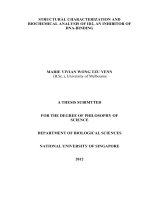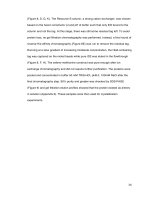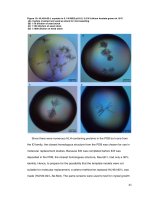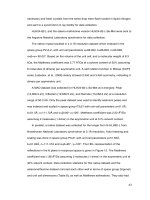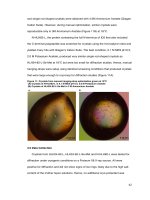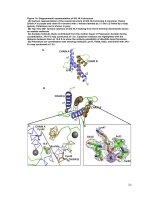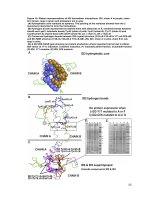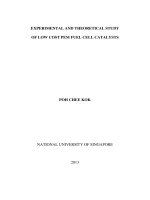Structural, magnetic and transport study of DBPLD fabricated magnetic semiconductors 4
Bạn đang xem bản rút gọn của tài liệu. Xem và tải ngay bản đầy đủ của tài liệu tại đây (946.54 KB, 66 trang )
CHAPTER 7: STUDIES ON THE MAGNETIC MECHANISM
CHAPTER 7
STUDIES ON THE MAGNETIC MECHANISM
7.1 Introduction
For the purpose of fabrication of room temperature DMSs, Co-doped ZnO materials
have been widely studies, and a considerable amount of experimental data have been
already accumulated. However, many discrepancies on magnetic behaviors were
involved. Even for those that were reported to be ferromagnetic, the origin of
ferromagnetism is often questioned. The origin of ferromagnetism in Co-doped ZnO
remains an issue of debates.
Till now, some investigations of the origin of magnetism in Co-doped ZnO were
reported. However, they studied the origin of ferromagnetism of Zn
1-x
Co
x
O thin films
either with Co clusters [1], or precluding the Co clusters by controling processing
parameters [2]. It seems that the origin of magnetic behaviors for Zn
1-x
Co
x
O thin films
is still not well understood, especially when the Co concentration is low (x < 0.1).
Since it is easier to understand that Co clusters may occur if more Co are incorporated,
which will definitely contribute to the ferromagnetic behavior of the Zn
1-x
Co
x
O thin
films. To be a candidate material to develop device in spintronics, it is essential to
ensure that the magnetism does not originate from the second phases. Thus, it is
significant to understand the origin of M-H hysteresis loops of Zn
1-x
Co
x
O thin films
with low Co concentrations (no apparent Co clusters). In this way, it is helpful to clear
National University of Singapore
121
CHAPTER 7: STUDIES ON THE MAGNETIC MECHANISM
the origins of ferromagnetism for Zn
1-x
Co
x
O thin films [3].
Several theories can be used to explain the magnetism in the absence of Co
clusters [4]. One is that ferromagnetism itself can be understood as being carrier
induced, in a similar fashion as the ferromagnetic state in the double-exchange model
for manganites at intermediate doping [5]. Another is related to
Ruderman-Kittel-Kasuya-Yosida (RKKY) interactions between the impurity spins. For
the former, carrier density is the crucial parameter determining the magnetization
behavior [6]. And, for the latter, RKKY might lead to spin glass behaviors in certain
spin lattices [7].
One important criteria for DMSs to be intrinsic has been suggested to be the
observation of the anomalous Hall effect (AHE) in the thin films [8]. Though the
criteria was questioned when both superparamagnetism and AHE were observed to
co-exist in highly reduced Co-doped Rutile TiO
2-
δ
films [9]. However, AHE testing is
still a tool to show the spin-orbital interactions in the materials. In this case, the
interactions need to be analyzed further. Photo-induced phenomena in diluted magnetic
semiconductors have attracted much attention due to the possible interpretations of the
origin of magnetic behaviors, in terms of the exchange interaction between the
photo-generated carriers and magnetic ions, if the magnetization could be manipulated
by light irradiation.
When studying magnetic phenomena in ferromagnetism, behaviors related to
ferromagnetic order, such as anisotropy, origin of domain are generally investigated.
To study a DMS system, the understanding of magnetic anisotropy is also important
National University of Singapore
122
CHAPTER 7: STUDIES ON THE MAGNETIC MECHANISM
[10]. Ref [11] studied the influence of magnetic anisotropy to indicate the role of the
hole concentration in the DMS system of (Ga,Mn)As in order to unveil the carrier
induced magnetism.
In the first part of this chapter, we will investigate whether magneto-crystalline
anisotropy exists or not. It is known that a magnetic material is said to possess
magnetic anisotropy if its internal energy depends on the direction of its spontaneous
magnetization with respect to the crystallographic axies [12
]. Experimental values of
anisotropy fields are commonly obtained by measuring magnetic polarization curves
with the field applied parallel and perpendicular to the easy magnetization direction
[12,13]. It is also noted that anisotropy energy is also produced by magnetostatic
energy due to magnetic free poles appearing on the outside surface or internal surfaces
of an inhomogeneous magnetic material. To proceed, we fabricated the film with c-axis
perpendicular and parallel to the substrate surfaces, and compared the magnetic
behaviors of these two kinds of thin films, hence to determine whether
magneto-crystalline anisotropy exists or not. To fabricate the Zn
1-x
Co
x
O thin films with
c-axis perpendicular and parallel to the substrate surfaces, we used different sapphire
substrates for matching of crystal lattice between the film and the substrate. It is well
known that substrates strongly affect crystal growth behaviors of films [14]. In the
second part of this chapter, we report on the relationship between the magnetism and
carrier density by comparing M-H loops with different carrier density in the films.
From our experimental results, we found no magneto-crystalline anisotropy in
Zn
1-x
Co
x
O thin films. There is no correlation between the origin of domain and carriers
National University of Singapore
123
CHAPTER 7: STUDIES ON THE MAGNETIC MECHANISM
in the Zn
1-x
Co
x
O thin films. Lastly, possible mechanisms for the magnetism of
Zn
1-x
Co
x
O thin films were proposed based on a picture of spins in a carrier sea.
7.2 Magnetic Anisotropy Study
Zn
1-x
Co
x
O with x = 0.05 precipitate-free single crystal thin films have been
fabricated by a DBPLD method under the optimum experimental condition. The films
were grown on (0001) sapphire (c-plane) and
)0211(
sapphire substrates (r-plane)
using the DBPLD method. The room temperature M-H curves were obtained by an
AGM with the magnetic field applied parallel to and perpendicular to the film planes at
room temperature. A Hall effect system was employed to measure the film
conductivity and carrier density with a Van der Pauw configuration at room
temperature. The sample was analyzed by X-ray diffraction (Philips, X’PERT-MRD)
to identify different crystal planes in the film. Detailed lattice structure and possible
precipitates were obtained by a HRTEM.
7.2.1 Structures of Zn
1-x
Co
x
O Thin Films Grown on c- and r- Sapphire Substrates
XRD images of the Zn
0.95
Co
0.05
O thin films are shown in Fig. 7-1. The film grown
on c-plane sapphire substrate is a single crystal with a wurtzite structure whose
c-axis is parallel to that of the substrate [Fig. 7-1(a)]. The lattice parameters of the film
was determined to be c = 0.5207 nm, which is a little larger than the reported values
for ZnO [15]. Figure 7-1(b) gives the XRD pattern of the Zn
1-x
Co
x
O (x = 0.05) film
grown on r-plane substrate. Diffraction peaks corresponding to
)0211(
plane of
Zn
1-x
Co
x
O thin film,
)2110(
,
)4220(
and
)6330(
planes of Al
2
O
3
were clearly
National University of Singapore
124
CHAPTER 7: STUDIES ON THE MAGNETIC MECHANISM
observed. No peak of other planes was detected by XRD. It is also wurtzite structure
with the film
)0211(
plane aligned with the substrate
)2110(
planes. The
)0211(
peak of the Zn
1-x
Co
x
O is located at 56.57 °. Insets of Fig. 7-1 show the Co 2p3/2 XPS
spectra for the films grown on c- and r-plane sapphire substrates. From the shape of the
spectra and position of the peaks, there is only Co – O bonding existed in the films in
both cases. From these results we referred that Co had substituted Zn-site in ZnO and
Co – O bonding exists in the host lattice. Based on the results of XPS and XRD, we
conclude that this material is a single compound with the replacement of Zn by Co.
Figure 7-2 gives X-ray rocking curves of thin films. The curves were taken from the
diffraction peaks at 34.44° for c-plane and 56.57° for r-plane substrates, respectively.
The FWHM is 0.18° for c-plane and 0.37° for r-plane sapphire substrates. This
indicates that the film grown on c-plane substrate has a more concentrated crystalline
orientation. In our view it is due to the higher surface energy of {0001} facet of ZnO
grown on sapphire substrate.
National University of Singapore
125
CHAPTER 7: STUDIES ON THE MAGNETIC MECHANISM
30 40 50 60 70
Zn
0.95
Co
0.05
O (0004)
770780790
Intensity (a.u.)
BE (eV)
Co2P3/2
Zn
0.95
Co
0.05
O (0002)
C-Al
2
O
3
(0006)
Intensity (a.u.)
2θ (Degree)
(a)
20 30 40 50 60 70 80 90
770780790
Intensity (a.u.)
BE (eV)
Co2P3/2
R-
Al
2
O
3
(3 0
-3 -6)
R-Al
2
O
3
(2 0 -2 -4)
Z
n
0
.
9
5
Co
0.
05
O
(
1 1
-2
0)
R-Al
2
O
3
(1 0 -1 -2)
Intensity (a.u.)
2θ (Degree)
(b)
Fig. 7-1 XRD images of Zn
0.95
Co
0.05
O thin films grown on (a) c-plane substrate and (b)
r-plane substrate, respectively. Insets show the corresponding XPS spectra of Co
2p3/2.
National University of Singapore
126
CHAPTER 7: STUDIES ON THE MAGNETIC MECHANISM
16.4 16.6 16.8 17.0 17.2 17.4
Intensity (a.u.)
θ (Degree)
FWHM 0.18
o
(a)
c-plane substrate
27.6 27.8 28.0 28.2 28.4 28.6 28.8 29.0 29.2
(b)
FWHM 0.37
o
Intensity (a.u.)
θ (Degree)
r-plane substrate
Fig. 7-2 X-ray rocking curves of Zn
0.95
Co
0.05
O thin films grown on (a) c-plane
substrate and (b) r-plane substrate.
National University of Singapore
127
CHAPTER 7: STUDIES ON THE MAGNETIC MECHANISM
s
)0006(
f
)0110(
s
)0211(
f
)0002(
Film
Sapphire
)0006(
)0002(
)0110(
)0211(
(a) (b)
)0211(
)4110(
)4220(
)0002(
f
)0211(
f
)0002(
Sapphire
Film
s
)4110(
s
)4220(
(c) (d)
Fig. 7-3 HRTEM images for Zn
0.95
Co
0.05
O films on c-plane substrate (a) film, substrate
and interface, (b) electron diffraction pattern taken on the interface; r-plane substrate (c)
film, substrate and interface, (d) electron diffraction pattern taken on the interface.
HRTEM images of Zn
0.95
Co
0.05
O thin film-substrate interface are shown in Fig. 7-3.
In Fig. 7-3(a), the interface between the film and c-plane substrate was found to be
smooth. The micrographs reveal well ordered lattice planes with few defects. No
precipitate was observed. From these images, the epitaxial relationship between the
film (f) and substrate (s), expressed by Exp. (5-2), agrees well with the XRD results.
National University of Singapore
128
CHAPTER 7: STUDIES ON THE MAGNETIC MECHANISM
In Fig. 7-3(c), the micrographs for those grown on r-plane sapphire substrate also
showed well ordered lattice planes with few defects. No precipitates was observed.
Although the interface between the Zn
0.95
Co
0.05
O thin film and r-plane sapphire
substrate was found to be clear, and the
)0211(
plane of the film parallel to the
)2110(
plane of the substrate, the lattice (0002) plane of the film was observed to be
tilt with respect to the substrate
)4110(
plane. This tilt can be observed more clearly
in Fig. 7-3(d). The tilt angle ϕ
1
is 6°. From the HRTEM diffractions and imaging
studies, the relationship between the film (f) and substrate (s), was determined to be as
follows:
sf
)2110//()0211(
, and
f
)0002(
s
)4110(
with an angle ϕ
1
of 6° between
the
and
f
)0002(
s
)4110(
. To determine the direction of c-axis of the Zn
0.95
Co
0.05
O
relative to the r-plane substrate, we can calculate the angle ϕ
2
using crystallographic
relationship,
41104220
41104220
2
cos
GG
GG
•
=
ϕ
, (7-1)
where G is reciprocal lattice vector, and ϕ
2
the angle between
4220
G
and
4110
G
.
Substituting the lattice parameters of film and substrate, we obtained
°= 84
2
ϕ
. This
verifies that the relationship
°
=
+
90
21
ϕ
ϕ
holds. The c-axis of the film lies in the
surface plane. The tilt angle between the
and
f
)0002(
s
)4110(
results in larger
FWHM of the rocking curves for the Zn
0.95
Co
0.05
O thin film grown on r-plane substrate.
From the lattice mismatching geometry shown in Fig. 7-3, we calculated and obtained
18% for the lattice mismatch of the Zn
0.95
Co
0.05
O thin films grown on c-plane substrate,
and 5% on r-plane substrate. This leads to a large compressive strain in the
Zn
0.95
Co
0.05
O thin films on the c-plane substrate.
National University of Singapore
129
CHAPTER 7: STUDIES ON THE MAGNETIC MECHANISM
7.2.2 Magnetic Properties of Zn
1-x
Co
x
O Thin Films Grown on c- and r- Sapphire
Substrates
The curves of Figure 7-4 show the M-H loops of the Zn
1-x
Co
x
O (x = 0.05) thin films
grown on c- and r-plane sapphire substrates. The coercivity Hc is about 100 Oe. This
result indicates in both cases, they are magnetic at room temperature. We emphasize
that different M-H loops can be obtained under different experimental conditions, as
shown in Fig. 7-4. From this figure, the film grown on the c-plane sapphire substrate
has a remanent squareness S of 0.056 when the applied magnetic field H is
perpendicular to c-axis of the film, and 0.041 when H is parallel to c-axis. For the
r-plane substrate, S is about 0.107 when H is perpendicular to
]0211[
of the film and
0.066 in the case of H perpendicular to c-axis. S is small for both r-plane and c-plane
substrates. There is no evidence of magneto-crystalline anisotropy for both film
orientations.
National University of Singapore
130
CHAPTER 7: STUDIES ON THE MAGNETIC MECHANISM
-8000-6000-4000-2000 0 2000 4000 6000 8000
-1.0
-0.5
0.0
0.5
1.0
(Out of plane)
(In plane)
-2000 0 2000
-0.5
0.0
0.5
M/Ms
Magnetic Field (Oe)
axisCH −//
axisCH −⊥
C-plane substrate
M/Ms
Magnetic Field (Oe)
(a)
-8000-6000-4000-2000 0 2000 4000 6000 8000
-1.0
-0.5
0.0
0.5
1.0
(Out of plane)
(In plane)
-2000 0 2000
-0.5
0.0
0.5
M/Ms
Magnetic Field (Oe)
]0211[⊥H
axisCH −⊥
r-plane substrate
M/Ms
Magnetic Field (Oe)
(b)
Fig. 7-4 Hystersis loops for Zn
0.95
Co
0.05
O films grown on (a) c-plane and (b) r-plane
sapphire substrate normalized to the saturation magnetization Ms. The data were taken
at room temperature with the external field both in plane and out of plane of the films.
Insets show enlarged images of the loops.
National University of Singapore
131
CHAPTER 7: STUDIES ON THE MAGNETIC MECHANISM
7.2.3 Semiconductor Transport Properties of Zn
1-x
Co
x
O Thin Films Grown on c-
and r- Sapphire Substrates
Electrical resistance is affected by the orientation of the crystal and strain produced
by stress, as shown in Table 7-1. From it, a smaller resistance is obtained for the
r-plane substrate film. It is reported that there is an effect of mechanical stress on the
electrical resistance of a conducting crystal [16]. Under our experimental conditions,
the c-axis of the film grown on c-plane substrates is perpendicular to the surface, while
the c-axis of the film grown on r-plane substrate lies in the surface plane. Therefore
Hall current must be associated with electrons jump in the plane which is
perpendicular to the c-axis for the film grown on c-plane sapphire substrate, while the
electrons jump in the plane of c-axis for r-plane substrate. The mismatch for Zn
1-x
Co
x
O
/ Al
2
O
3
in r-plane system is smaller than that in c-plane sapphire system. The smaller
lattice mismatch and a tilt angle in r-plane system result in the strain in the film
partially relaxed [17]. Hence, the film grown on r-plane substrate has a smaller strain.
A smaller resistance is obtained for the r-plane substrate film. The larger strain is the
reason for a higher resistivity.
National University of Singapore
132
CHAPTER 7: STUDIES ON THE MAGNETIC MECHANISM
Table 7-1 Electrical transport properties for Zn
0.95
Co
0.05
O films grown on c- and
r-plane sapphire substrates at room temperature from the Hall effect measurements
Sample Type Resistivity
(mΩ cm)
Carrier density
(cm
-3
)
c-plane substrate n 500 6x10
17
r-plane substrate n 100 7x10
18
Both the Zn
1-x
Co
x
O with x = 0.05 thin films have a wurtzite single crystal structure.
There was no precipitates observed in both cases under HRTEM. The thin film c-axis
is perpendicular to the film plane for samples grown on c-plane substrates, and lies in
the film plane for samples grown on r-plane substrates. By comparing the M-H curves
of the two kinds of thin films, they are soft magnetic materials with small remanent
squareness for both film orientations. Hence, based on our experimental results, no
crystalline anisotropy was observed in the Zn
1-x
Co
x
O system. From the physical point
of view, a magnetic material is said to possess magnetic anisotropy if its internal
energy depends on the direction of its spontaneous magnetization with respect to the
crystallographic axies. In hexagonal crystal structures, in most cases, the preferred
agnetization direction will be along the c-axis [12]. As it has been reported in [10, 18,
19], the strain induced anisotropy of the valence band can result in a sizable anisotropy
of spin properties in (Ga,Mn)As DMS system. However, in our studies, no evidence
was found to verify the magneto-crystalline anisotropy in this Zn
0.95
Co
0.05
O system. In
addition, the lattice mismatch of the Zn
0.95
Co
0.05
O thin films grown on c-plane
substrates is larger, and the film grown on c-plane substrate showed larger Hall
National University of Singapore
133
CHAPTER 7: STUDIES ON THE MAGNETIC MECHANISM
resistivity and lower carrier density. In our view, the larger strain in the Zn
1-x
Co
x
O thin
films grown on c-plane substrates leads to the distortion of the lattice. This effect
contributes to the Co ions locating at the center of the octahedron, which we have
discussed in Chapter 5.
7.3 AHE and Light Response Study
7.3.1 Anomalous Hall Effect (AHE)
In our studies, a Hall bar specimen of the 6-point Hall bar geometry with (1-2-2-1)
configuration was used. The size of the Hall bar has been illustrated earlier. Figure 7-5
shows the schematic geometry of the AHE measurement.
Hall bar (1-2-2-1)
xy
R
xx
R
2
1
4
3
6
5
H
x
y
z
α
Fig. 7-5 Geometry of the AHE measurement. α is the angle between the applied field
H and the normal to the sample.
In the Hall effect measurement for a ferromagnetic material with the B field lying
in the plane of current and the normal of the surface, there are two Hall voltage
components [20]. The Hall resistivity
B
ρ
can be defined by
ϑ
α
ρ
coscos
0
MRBR
AH
+
=
(7-2)
where
is the ordinary Hall coefficient, B is the magnetic flux density, is the
anomalous Hall coefficient, M is the magnetization of the film, α is the angle between
0
R
A
R
National University of Singapore
134
CHAPTER 7: STUDIES ON THE MAGNETIC MECHANISM
the applied field and the normal to the sample,
θ
is the angle between the
magnetization and the normal to the sample. The first term in Eq. 7-2 is the ordinary
Hall effect (OHE) and arises from the Lorentz force acting on conduction electrons.
The OHE depends on the z-component of the B field (
), and produces an electric
field perpendicular to
and the current density. The second term is the AHE and is
due to spin dependent scattering mechanisms. The AHE depends on the perpendicular
component of M, and produces an electric field perpendicular to the perpendicular
component of M to the surface plane and the current density.
Z
B
Z
B
Figure 7-6 shows a small Hall AHE signal of Zn
1-x
Co
x
O thin film with x = 0.05 after
proper data extractions under the condition of
α
= 45°, though the signal is small. It is
an evidence that AHE was observed in the Zn
1-x
Co
x
O thin film. It is known that there is
no AHE reported in Zn
1-x
Co
x
O thin films in which Co is suggested to be more
uniformly distributed. In the light of our experimental conditions, the AHE signal is
dominant for lower magnetic field and can be evaluated by subtracting the linear
background. Under our experimental conditions, only a few samples show the AHE
signals and they are not pronounced.
National University of Singapore
135
CHAPTER 7: STUDIES ON THE MAGNETIC MECHANISM
-400 -200 0 200 400
-0.04
-0.02
0.00
0.02
0.04
Hall Resistivity (Ω cm)
Magnetic flux density (G)
Co 0.05
Fig. 7-6 AHE signal of Zn
1-x
Co
x
O with x = 0.05 thin film.
It is universal thought that AHE relies on spin-orbit coupling between the carrier and
the lattice, which produces a left-right asymmetry in the scattering [21]. AHE is
considered as a tool to test the ferromagnetic response of charge carriers in
ferromagnetic semiconductors [22]. In general, skew scattering provides a mechanism
of AHE. Namely, the skew scattering is caused by an anisotropy of the sp-d interaction.
Hence, the observation of AHE shows that there presents sp-d interactions, indicating
that the magnetization direction follows the field direction [17]. The shape of the Hall
resistance can be understood as the reflection of the field dependence of M, though the
magnetic field range did not reach the saturation value due to the limits of the
experimental conditions.
National University of Singapore
136
CHAPTER 7: STUDIES ON THE MAGNETIC MECHANISM
Applying the Hall effect measurements results, the evaluation of
000
/)(/
ρ
ρ
ρ
ρ
ρ
−
=
∆
B
(7-3)
as a function of B for a given direction of I and B with respect to the crystal axes were
obtained, where
B
ρ
is the Hall resistivity at a field of B,
0
ρ
is the
B
ρ
with 0
=
B .
To compare the effect in constancy, we evaluated it while setting B at 500 Gauss. In
this experimental arrangement, B rotates from α = 0 to α = 90°. The result of
0
/
ρ
ρ
∆
dependence on α is depicted in Fig. 7-7. It can be seen that
0
/
ρ
ρ
∆
decreases as α
decreases, following a cosine dependence on α. It agrees with the first term in the Eq.
7-2. It is well known that the OHE depends on the perpendicular component of the B
field, and produces an electric field perpendicular to the perpendicular component of B
and the current density. From Eq. 7-2, at the point of B = 500 Gauss, the AHE’s
contribution is small compared to the OHE term.
National University of Singapore
137
CHAPTER 7: STUDIES ON THE MAGNETIC MECHANISM
0 20406080100
-0.002
0.000
0.002
0.004
0.006
0.008
0.010
α
ρ
ρ
θ
cos
0
∗
∆
=
H
delta ρ/ρ
0
Angle (α)
Exp
Theo:
Fig. 7-7 Dependence of
0
ρ
ρ
∆
on angle α obtained by Hall effect measurement of the
Zn
1-x
Co
x
O thin film with x = 0.05.
7.3.2 Magnetism Response to Light Irradiation
From the physical point of view, DMSs should exhibit AHE. However an observed
AHE signal might not be enough to fulfill the criteria of DMS. For example, AHE can
be found from a spin-orbit coupling in the interaction between band quasiparticles and
crystal defects [23]. In fact, AHE were observed in ferromagnetic metals,
anti-ferromagnetic metals and semiconductors [21]. Probably it is the reason for the
co-occurrence of superparamagnetism and AHE in Cobalt-doped Rutile TiO
2
[9].
To clarify the origin of magnetism, we applied the light source in the Hall effect
system, as shown in the Fig. 7-8. The relationship between the magnetism and carrier
National University of Singapore
138
CHAPTER 7: STUDIES ON THE MAGNETIC MECHANISM
is directly reflected through the response of the Zn
1-x
Co
x
O thin film (x = 0.05) to the
light irradiation with the wavelength of 313 nm. Figure 7-9 shows that under the
condition of light irradiation, the Hall resistivity decreases while the carrier density
increases. In contrast, when the light is off, the Hall resistivity increases while the
carrier density decreases. It indicates that the light irradiation can increase the carrier
density of the film.
45
0
Magnet for
Hall effect
Sample
Light
source
Filter
Fig. 7-8 Schematic diagram of AHE measurement under the light irradiation of a
hand-held light source.
National University of Singapore
139
CHAPTER 7: STUDIES ON THE MAGNETIC MECHANISM
2000 3000 4000 5000 6000
0.06280
0.06285
0.06290
0.06295
0.06300
Magnetic flux density (G)
dark
dark
dark
dark
light
lightlight
Hall resistivity (Ω cm)
Resistivity
light
-1.5x10
18
-1.0x10
18
-5.0x10
17
0.0
Carrier density (1/cm
3
)
Carrier density
Co 0.05
Fig. 7-9 Hall resistivity and carrier density response to light irradiation obtained by the
Hall effect measurement.
The Zn
1-x
Co
x
O thin films are n-type semiconductors. When the film was irradiated
with a light with photon energy larger than the band gap of the film, electrons near the
valence band will be excited into the conduction band. The amount of the electrons
contributing to the un-equilibrium local spin-density distribution due to the double
exchange mechanism will also be changed. Hence the variance in the carrier density
characterized by the Hall effect measurement may be a point to the variance in the
electrons contributing to magnetism in DMS, if this mechanism works. And vice versa.
Hence to clarify the spin-orbit interactions in Fig. 7-6, we repeated the testing under a
light irradiation with the wavelength of 313 nm. However we failed to obtain an
enhanced AHE signal after the light irradiation (not shown here). If the correlations
between the global ordering of the Co
2+
local moments and carrier density work in this
National University of Singapore
140
CHAPTER 7: STUDIES ON THE MAGNETIC MECHANISM
spin system, the magnetic moment can be mediated by carrier density, and the AHE
signals should be enhanced. Otherwise, there is no evidence to show the correlations
between magnetic and transport properties in the magnetic system.
Following this, we also applied the light source in the AGM system to compare the
M-H curves at different carrier densities, as shown in Fig. 7-10(a). Figure 7-10(b)
presents typical M-H curves of the Zn
1-x
Co
x
O thin film (x = 0.05) before and after light
irradiation with the wavelength of 313 nm. Here we give an explanation about the
plotting. The M-H loops are plotted with the same scale of y-axis but a shift of x-axis
in order to give a clear comparison. It can be seen that there is no observable difference
between the M-H curves obtained before and under the condition of light irradiations.
In our view, if the correlation between the global ordering of the Co
2+
local moments
and carrier density in this spin system exists, the magnetic moment should be mediated
by carrier density. On account of our experimental results, we conclude that there is no
such correlation.
National University of Singapore
141
CHAPTER 7: STUDIES ON THE MAGNETIC MECHANISM
Magnet for
AGM
Sample
Light
source
Filter
(a)
-6000 -4000 -2000 0 2000 4000 6000
-0.00006
-0.00004
-0.00002
0.00000
0.00002
0.00004
Magnetic moment (emu)
Magnetic Field (Oe)
Before light
-6000 -4000 -2000 0 2000 4000 6000
-0.00004
-0.00002
0.00000
0.00002
0.00004
Light irradiation
(b)
Fig. 7-10(a) Schematic diagram of the light response measurement for M-H curves
under the light of a hand-held light source. (b) Comparative M-H curves before and
under that light of a hand-held light source.
National University of Singapore
142
CHAPTER 7: STUDIES ON THE MAGNETIC MECHANISM
7.4 Magnetic Mechanisms Proposal
7.4.1 Electron Configuration and Exchange Interactions in Zn
1-x
Co
x
O Thin Films
On account of our experimental results and understanding, the Zn
1-x
Co
x
O system
can be regarded as the case of Co
2+
(d
7
) in a tetrahedral field [24]. From our absorption
results, the many electron ground states are singlet A
2
. We observed the absorption
band to the d-d transition of the Co
2+
impurity in Zn
1−x
Co
x
O, indicating the band
splitting, i.e., the trigonal splitting of
.
)(
1
4
PT
Our experimental results show that Zn
1-x
Co
x
O thin films have similar band
structures to that of ZnO, in particular when x is small. Here, it is reasonable to
consider that
locates in the center of the bandgap, and the relative position of
Fermi level and the top of the valence band,
F
E
vF
EE
−
for Zn
1-x
Co
x
O is that
eV, similar to that of ZnO [25]. In Fig. 5-14(b), band structures
presenting Zn 3d, O 2p hybridization with Zn s(p), non-bonding O 2p with Co 3d were
observed. It is also known that Zn
6.1≈−
vF
EE
1-x
Co
x
O thin films have a wurstzite-type lattice. In
the films, Co atoms substitute Zn-sites with the tetrahedral symmetry. The
valence
states involve mostly anion (O
8
Γ
2-
) p orbitals. The hybridization related to
8
Γ
is
important. We will concentrate ourselves on this p-d hybridization in the following
discussions.
In the Zn
1-x
Co
x
O thin films, since the tetrahedral field resolves the d levels of Co
3d into
and representations but in inverted order, the outer electron
configuration of Co
g
t
2 g
e
2+
(d
7
) is , as shown in Fig. 7-11. The configuration
presents those contributing to the p-d exchange interaction, namely, in a tetrahedral
23
2
2
↓↑↑ ggg
ete
National University of Singapore
143
CHAPTER 7: STUDIES ON THE MAGNETIC MECHANISM
field, the fivefold degenerate d orbitals split into triply degenerate levels (t
2g
) and
doubly degenerate levels (e
g
). The orbital degeneracy is shift by increasing the energy
of the three
orbitals hybridizing with
g
t
2
8
Γ
-band states as compared to the two
orbitals. In these states, all the
orbitals are singly occupied, while the sixth and
seventh electrons occupy
orbitals [26].
g
e
g
t
2
g
e
t
2g
e
g
Fig. 7-11 Schematic outer electron configuration of Co
2+
(d
7
) in Zn
1-x
Co
x
O.
7
3dCo
),(
222
zyx
g
dde
−
),,(
2 yzxzxyg
dddt
*)(
2
π
g
t
6
2 pO
σ
π
*)(
σ
g
e
(a)(a)
(b) (b)(c)
Fig. 7-12 A schematic energy diagram of the p - d band of interest in Zn
1-x
Co
x
O
magnetic system with O 2p states by the Co 3d states. (a), (b) and (c) show the atomic
unpolarized level, the exchange split atomic levels and the final interacting states,
respectively.
National University of Singapore
144
CHAPTER 7: STUDIES ON THE MAGNETIC MECHANISM
In summary, under our experimental conditions, Co atoms substitute Zn-sites in ZnO,
hence there is a tetrahedral crystal field applied on the Co ions. The Zn
1-x
Co
x
O system
can be regarded as the case of Co
2+
(d
7
) in a tetrahedral field of ZnO, as shown in Fig.
7-12. The exchange interaction between the p band in the valence band and the d
electrons is mainly derived from the p-d hybridization. Especially at the
point, the
top of the valence band is constructed purely from the anion p orbitals that can only
hybridize with the d orbitals of t
Γ
2
symmetry. In Co
2+
impurities, where the t
2
orbitals
are half-filled, only those ligand band whose spins are antiparallel to that of the
transition-metal impurity can be transferred into the unoccupied t
2
orbitals [27].
In DMSs, two fundamental interaction mechanisms are considered: the direct
Coulomb exchange and the kinetic exchange. The former is known to favor the parallel,
or ferromagnetic, alignment of the interacting spins, and the latter can lead to an
antiferromagnetic-like interaction if the hybridization exchange constant is negative.
Let us estimate the exchange interaction in the Zn
1-x
Co
x
O thin films by calculating the
p-d exchange constant per unit volume (
β
0
N
).
Kinetic exchange, i.e., the hybridization of the band states with localized ionic d
orbitals, may be viewed as a second-order perturbation effect involving virtual
transition of an electron between the band states and ionic orbitals [26]. As we have
discussed before, Zn
1-x
Co
x
O thin films have similar electrical structure to that of ZnO,
in particular when x is small. In Zn
1-x
Co
x
O, the conduction band is mainly formed by
the s orbitals of the cation, and the valence band by the p orbitals of the anion. The
exchange interaction between the s electrons in the conduction band and the d
National University of Singapore
145
